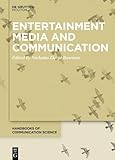Entertainment Media and Communication / ed. by Nicholas David Bowman.
Material type: TextSeries: Handbooks of Communication Science ; 20Publisher: Berlin ; Boston : De Gruyter Mouton, [2024]Copyright date: 2024Description: 1 online resource (XIII, 703 p.)Content type:
TextSeries: Handbooks of Communication Science ; 20Publisher: Berlin ; Boston : De Gruyter Mouton, [2024]Copyright date: 2024Description: 1 online resource (XIII, 703 p.)Content type: - 9783110792812
- 9783110792935
- 9783110792881
- 302.23
- online - DeGruyter
- Issued also in print.
| Item type | Current library | Call number | URL | Status | Notes | Barcode | |
|---|---|---|---|---|---|---|---|
 eBook
eBook
|
Biblioteca "Angelicum" Pont. Univ. S.Tommaso d'Aquino Nuvola online | online - DeGruyter (Browse shelf(Opens below)) | Online access | Not for loan (Accesso limitato) | Accesso per gli utenti autorizzati / Access for authorized users | (dgr)9783110792881 |
Frontmatter -- Acknowledgements -- Contents -- About the Editor -- Preface to Handbooks of Communication Science series -- General Introduction -- Media Entertainment Theory and Research: Still an Amorphous Area -- Section 1: Retrospectives and Foundations -- Chapter 1 Media Effects Paradigms: Was There Ever a Magic Bullet? -- Chapter 2 The Early Development of Audience Entertainment Research, 1937–1940 -- Chapter 3 Humor and Mirth -- Chapter 4 Emotion and Entertainment -- Chapter 5 Audio-Visual Formal Features of Entertainment Messages -- Chapter 6 Encoding/Decoding Entertainment Media -- Section 2: Key and Canonical Theories -- Chapter 7 Narratives and Entertainment Media -- Chapter 8 Parasocial Interaction and Parasocial Relationship -- Chapter 9 Affective Disposition Theory -- Chapter 10 Uses and Gratifications Theory -- Chapter 11 Cultivation Theory and Entertainment -- Chapter 12 Identification with Characters in Narratives -- Chapter 13 Media Selection Processes in Entertainment -- Chapter 14 Media Habits and Entertainment -- Section 3: Considerations of Content/Genre/Type/ Setting -- Chapter 15 Crime Entertainment Media -- Chapter 16 Horror as Entertainment -- Chapter 17 Sport as Entertainment -- Chapter 18 Representation Matters: Ethnic/Racial Depictions in US Entertainment Media and the Implications for Audiences -- Chapter 19 Political Satire -- Chapter 20 Love It and/or Hate It: Journalism as Entertainment -- Chapter 21 Entertainment Media’s Effects on Child Audiences -- Chapter 22 Risk Behavior and Entertainment -- Chapter 23 Sexual Content, Sexuality in Media -- Chapter 24 Aggression and Violence in Entertainment Media -- Chapter 25 Entertainment-Education Media: Where Learning Is Fun -- Chapter 26 Transcendence and “Inspiring Media” -- Chapter 27 Branded Entertainment as a Win–Win Strategy for Consumers and Advertisers -- Section 4: Critical and Cultural Considerations -- Chapter 28 Searching for Meaning: Positioning Fan Research within Trends in Communication Studies -- Chapter 29 Gender, Identity, and Entertainment -- Chapter 30 Globalisation -- Chapter 31 Surveillance and Entertainment -- Chapter 32 Postcolonial Theory and Media Entertainment -- Chapter 33 The Role of Paratexts in Media Entertainment -- Chapter 34 Feminist Media Studies and Entertainment -- Chapter 35 Mediatization and Entertainment -- Chapter 36 Spaces and Places in Entertainment -- Section 5: Digital Media and Technology -- Chapter 37 Extended Reality and Metaverse Technology -- Chapter 38 Streaming Media and Entertainment Experiences -- Chapter 39 Esports and Game Streaming -- Chapter 40 Video Games as Entertaining-yet-Demanding Interactivity -- Chapter 41 Media Multitasking and Entertainment -- Chapter 42 Analytics in the Entertainment Industry -- Section 6: Advances and Conclusions -- Chapter 43 Priming and Exemplification: Implications for Entertainment -- Chapter 44 The Biology of Entertainment -- Chapter 45 Computational Modeling Entertainment Media Choice and Decision-Making in Communication Science -- Chapter 46 The Role of Theory in Media Entertainment Research -- Author Biographies -- Index
restricted access online access with authorization star
http://purl.org/coar/access_right/c_16ec
Although not considered a formal area of study, scholarship on the uses, content, and effects of entertaining media has been central to communication studies and related fields for more than a century. The serious study of entertainment seems paradoxical, as we presume entertainment to be the “lighter side” of our daily lives. Yet as revealed in this volume, entertainment media serve as cultural artifacts that shape our understandings of various peoples and publics in ways that invite deeper, immersive, and increasingly interactive engagement. On this backdrop, Entertainment Media and Communication serves as a reference guide for canonical and foundational research into media entertainment and a collection of emerging and updated theories and models core to the study of media entertainment in the 21st century. Across more than forty chapters and with a diverse and inclusive list of authors, this volume provides a broad-yet-nuanced view into entertainment media and communication scholarship. The contributors explore its foundations, define and extend key concepts and theories through myriad lenses, discuss unique considerations of digital media, and divine future paths for scholarly inquiry.
Issued also in print.
Mode of access: Internet via World Wide Web.
In English.
Description based on online resource; title from PDF title page (publisher's Web site, viewed 20. Nov 2024)


